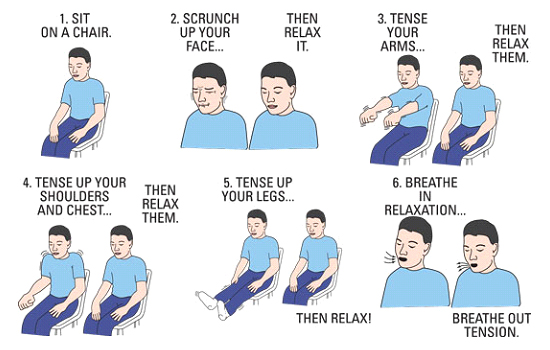One of the body’s responses to fear and anxiety is creating muscle tension. This can result in feeling “tense”, or anxiety/stress can lead to muscle aches and pains, as well as leaving your body feeling exhausted. Muscle relaxation can be particularly helpful in cases where anxiety is especially associated to muscle tension. The following information can be used like an exercise prescription to guide you through a common form of relaxation designed to reduce muscle tension.
Muscle tension is commonly associated with stress, anxiety and fear. Our bodies use these emotions in preparation for a potentially dangerous situation and that is when the body tenses up, however, most of the time these situations may not actually be dangerous. Majority of the time we don’t even realize that our muscles have become tense so these following exercises will allow you to distinguish the difference between a relaxed state and a tense state and how to coordinate between the two in a tense situation. Muscle tension can be associated with jaw pain, backaches, tension headaches and overall muscle tightness.
A common method of reducing muscle tension and teaching yourself how to relax your muscles is Progressive Muscle Relaxation (PMR). The first step requires you to tense particular muscle groups in your body and the second step requires you to release the tension and be consciously aware of how your muscles feel when you release them. PMR will help you become more aware of your overall tension and therefore be able to relax when you’re feeling anxious or stressed.
- Find a quiet room and set some time aside to begin the relaxation exercises
- Slow down your breathing for a few moments before going onto the following steps
- Begin by tensing the muscle groups described, make sure you feel the tension the whole time. Take care not to hurt yourself, you should never feel any sharp or shooting pain. Keep the muscles tensed for approximately 5 seconds.
- After tensing the muscles for 5 seconds, then relax the muscles and keep them relaxed for 10 seconds.
- When you have finished the relaxation procedure, remain seated for a few moments.
Throughout this exercise you will be working with all the major muscles groups in your body. An easy sequence to help you remember all the muscles is by starting with your head and systemically move down to your feel, or if you prefer you may do the reverse and start from your feet and move up.
You may follow the image as an example:

Slow Breathing Exercises
It is good to practice these steps regularly when you’re noticing the first signs of anxiety, anger or any type of overwhelming emotion.
- Take one deep breath in and when you breathe out exaggerate the motions by letting go of all muscle tension in your shoulders and neck – shake them loose. When you breathe out say the word relax to yourself in a calm, soothing manner.
- Breathe in and out slowly through your nose. Breathe in for 3 seconds (through your nose), hold for 1 second, then breathe out for 3 seconds (through your nose, or pursed lips if you are having trouble with this) and hold again for 1 second.
- Say the word relax to yourself every time you breathe out.
- Continue breathing in this way until all the symptoms of over-breathing have gone (2-5 minutes).
Lakeside Chiropractic is located centrally in the Perth Northern suburb of Joondalup. With visitors from a large range of suburbs, including: Alkmos, Tapping, Hocking, Ridgewood, Butler, Quinns Rock, Greenwood, Marangaroo and Hamersley. We are a Medibank Member Preferred practitioner. HICAPS facilities are also available, enabling immediate claim backs from all major health care providers, confirm with us if you are unsure about your health insurer. If you would like to discuss our treatment options available to you or to book an appointment with one of our friendly and professional Chiropractors, please contact us on 08 9300 0095.



